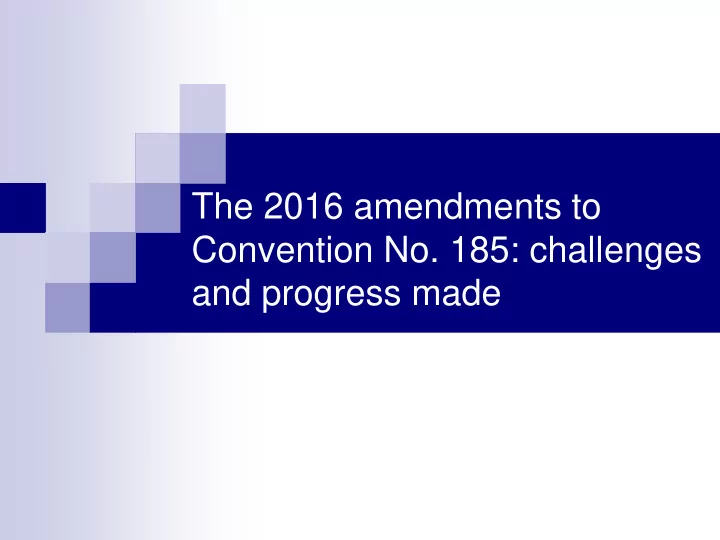

The 2016 amendments to Convention No. 185: challenges and progress made
History of Convention No. 185 • Adopted in 2003 to replace Convention No. 108 with a modern, uniform identity document including biometrics • Diverged from ICAO Doc 9303 for passports when ICAO moved to ePassport with chip in 2006 • Verification of fingerprints contained in a two dimensional barcode was difficult at borders and ports as required equipment was typically not available • Ratification was slow, but implementation slower still • In 2015 and 2016, tripartite maritime meetings held in consultation with ICAO to recommend amendments • Governing Body approved amendments in March, 2016 • ILC adopted amendments in June, 2016 • Amendments came into force June, 2017
Summary of Amendments • Convention No. 185 references Doc 9303 seventh edition “as it may subsequently be amended in accordance with the related procedures of ICAO”. Can no longer lose coordination with ICAO • SID can be of TD1, TD2 or TD3 size (passport page, credit card or visa sticker) • Barcode and fingerprints removed • Biometric is now facial image in contactless chip • Logical Data Structure (LDS) in eSID works exactly like that of an ePassport and can be read by all ePassport readers • All border points should now support verification of eSID • BUT….. Distribution of keys to verify digital signature in chip is a new critical element required for success
Progress on C185 C108 C185 C185 Amendments No Biometric, Fingerprints, Low Security MRZ, Face Recognition Better MRZ + Chip Security High Security Ratified 64 35 34 Provisionally 0 1 0 Adopted In Force 64 34 33 Must Issue eSID No No Yes Must Accept eSID Yes Yes Yes 98 countries are bound to accept the eSID but only 34 to issue it
Progress on C185 Amendments • A transition period for the amendments to C185 was offered, but only one country, Marshall Islands, has opted against immediate entry into force • This means issuance of eSIDs is an immediate obligation for 33 countries (plus Myanmar in July, 2018) • ICAO agrees that C185 and ICAO Doc 9303 are now completely aligned • Any border that supports an ePassport can also support an eSID • A new checklist is posted on ILO web site with detailed requirements for all aspects of implementation (http://www.ilo.org/global/standards/maritime-labour- convention/WCMS_617300/lang--en/index.htm) • Some countries have already begun to implement
Challenges for C185 Amendments • Expertise on electronic travel documents is usually found with passport issuers and not maritime authorities • Use of an eSID following ICAO Doc 9303 requires distribution of keys so that the eSID can be verified at the border • This greatly increases usability but also increases complexity and cost • Cooperation with passport issuing departments is the simplest route, but not always possible • How does the eSID issuer tackle this problem?
Problem of Key Distribution • ICAO PKD can be available even if your country doesn’t currently issue an ePassport • ICAO will offer advice in their presentation • With cooperation of another friendly country, keys can be distributed to the PKD using a master list • Currently less than half of ePassport issuing countries are actually members of the ICAO PKD • Companies with expertise in ePassport issuance may have suggestions on how to arrange key distribution
Problem of Cost and Complexity • Companies with suitable expertise can help with the complexity (three companies are outside, all have provided eSIDs whose physical designs have been checked for compliance with C185) • Since fingerprints have been replaced with facial recognition, enrolment is easier • Sharing resources and facilities between departments (ePassport and eSID) or between countries (cards can be printed and personalized remotely) can save a lot • Make ILO Checklist part of your procurement (ensures that SID will be compliant to C185) • Ask ILO for technical help • Dr. Campbell will be available all day Thursday
Summary • C185 Amendments define a secure eSID that is compatible with ePassports • Enrolment of seafarers is easier • Acceptance at border is better • Costs and complexity are higher, but can be reduced by sharing resources • Follow ILO SID Checklist, use a reliable company, and get it right the first time
Recommend
More recommend